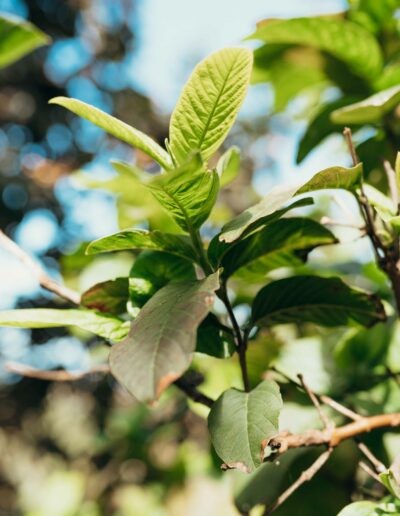Psidium guajava
Guava, Guayaba, Goiaba
Englische Bezeichnung: Common guava, Yellow guava, Lemon guava
Spanische Bezeichnung: Guayabo
Familie
Myrtengewächse (Myrtaceae)
Verwendbare Teile:
Frucht, Blätter
Hauptbestandteile:
Mineralstoffe: Kalium, (Zink in den Blättern)
Vitamine: B-Vitamine, C, Beta – Carotin (Provitamin A), Folsäure
Sekundäre Pflanzenstoffe: Antioxidantien (Quercitin, Flavonoide…)
Blätter: phenolische Verbindungen, Isoflavonoide, Catechin, Rutin, Kaempferole, …
Ernte-Hinweise:
Die Reife ist zu erkennen an der Gelbfärbung der Frucht sowie einem intensiven Geruch. Gelegentlich fällt auch die eine oder andere Guave von selbst ab – ein sicheres Zeichen dafür, dass sie reif ist.
Verwendung:
-
Frucht: Obstsalat, Smoothies, Verzierung von Kuchen
-
Blätter: Tee
Guaven stammen ursprünglich aus dem brasilianischen Raum. Der Geschmack erinnert an eine Mischung aus Birne, Quitte, Feige, mit einem Hauch Erdbeere. Die Blätter stellen eine hervorragende Zink-Quelle dar und werden für verschiedene Beschwerden eingesetzt.
Family
Myrtle family (Myrtaceae)
Usable parts:
Fruit and leaves
Main components:
Minerals: Potassium, (zinc in the leaves).
Vitamins: B vitamins, C, beta – carotene (provitamin A), folic acid.
Secondary plant substances: antioxidants (quercitin, flavonoids…)
Leaves: phenolic compounds, isoflavonoids, catechin, rutin, kaempferols, …
Harvesting guideline:
Ripeness can be recognised by the yellow colouring of the fruit and an intense smell. Occasionally, one or the other guava falls off by itself – a sure sign that it is ripe.
Use:
Fruit: Fruit salad, smoothies, cake decoration…
Leaves: tea
Guavas originate from the Brazilian region. The taste is reminiscent of a mixture of pear, quince, fig, with a hint of strawberry. The leaves are an excellent source of zinc and are used for various ailments.
Familia
Familia de los mirtos (Myrtaceae)
Partes utilizables:
Frutos y hojas
Componentes principales:
Minerales: Potasio, (zinc en las hojas).
Vitaminas: Vitaminas del grupo B, C, beta – caroteno (provitamina A), ácido fólico.
Sustancias vegetales secundarias: antioxidantes (quercitina, flavonoides…
Hojas: compuestos fenólicos, isoflavonoides, catequina, rutina, kaempferoles, …
Guía de rosecha:
La madurez se reconoce por la coloración amarilla del fruto y un olor intenso. En ocasiones, alguna guayaba se cae sola, señal inequívoca de que está madura.
Uso:
Frutas: Macedonia de frutas, batidos, decoración de tartas..
Hojas: té
Las guayabas son originarias de la región brasileña. Su sabor recuerda a una mezcla de pera, membrillo e higo, con un toque de fresa. Las hojas son una excelente fuente de zinc y se utilizan para diversas dolencias.







































